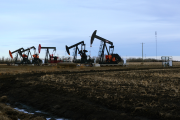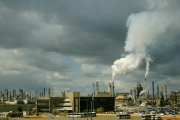The release of a controversial U.S. State Department environmental impact assessment late last week signalled a new phase in the battle over the Keystone XL pipeline proposal. The already-tense process looks set to get even more fraught as the technical phase starts to wrap up and the decision shifts squarely into the political arena.
Here in Canada, U.S. Ambassador David Jacobson clearly touched a nerve when he went public last month with the message that our country, like the U.S., should do more to tackle global warming. His words seemed to suggest that weak climate policy in Canada would make it difficult for President Obama to approve the proposed pipeline.
That implication produced a flurry of political responses, including dismissals from Stephen Harper’s cabinet ministers that there’s anything wrong with Canada’s climate policy and lobbying trips to Washington from western premiers. The Ambassador’s comments also kicked off speculation about a “quid pro quo” that would swap stronger Canadian climate policy for U.S. approval of the pipeline.
If a secret deal is in the works, I certainly wouldn’t know about it — arrangements between presidents and prime ministers fall more than a few rungs above my pay grade. But there’s a much more straightforward explanation for Ambassador Jacobson’s words: Canada’s approach to tackling greenhouse gas pollution has always been a central part of the KXL decision, and perhaps the U.S. has simply decided to say that aloud.
The logic is pretty simple:
President Obama just used a couple of very high-profile occasions to pledge stronger action on climate change in his second term.
Climate change doesn’t respect national borders — it’s a global problem.
The Keystone XL proposal would make climate change worse by enabling more greenhouse gas pollution from the oilsands. (That’s not a position everyone agrees with, so we’ll come back to it later on.)
And despite years of promises from four successive environment ministers, the federal government has not imposed any regulations or policies to reduce the climate change impacts of the booming oilsands sector. As of today, Environment Canada has yet to announce even the outlines of an approach to tackling oil and gas emissions.
In that context, giving a thumbs-up to Canada’s approach by approving the KXL pipeline would call President Obama’s recent strong words on global warming into question.
I don’t know whether President Obama wants to approve the pipeline. But what Ambassador Jacobson is saying is that Canada hasn’t made it easy to say yes.
It might not be obvious why this particular pipeline would be bad news for the climate. After all, isn’t it just a way to get Alberta’s bitumen (the extra-heavy oil produced in the oilsands) to markets? Doesn’t the U.S. have to get its oil from somewhere?
That view got a boost from the U.S. State Department in a draft environmental impact statement, released on Friday, which concluded that the Keystone proposal would have little impact on overall greenhouse gas emissions. The assessment argues that because U.S. Gulf Coast refineries need heavy crude to process, the so-called “midstream industry” (which falls between extraction and processing of petroleum products) will find a way to get Alberta’s bitumen to refineries, whether it’s through the KXL pipeline, on rail, on via some other proposal. So KXL wouldn’t matter much from a climate change perspective, the State Department argued, because the approval or denial of any one oil transportation project won’t change the bigger picture.
We take a very different view than the State Department’s: we believe that the Keystone proposal would make it possible for oilsands production to grow significantly.
Our analysis concluded that filling the pipeline with oilsands bitumen would enable up to a 36 per cent increase from current production levels; the greenhouse gas pollution associated with that production is equivalent to adding well over 4 million cars to the road.
Opponents and supporters of the proposal tend to agree that unless companies can find new ways to get bitumen to market, they won’t go ahead with the expanded production they have planned. (And a quick skim through the business section of Canadian newspapers reveals a lot more concern about the viability of alternative proposals to get bitumen out of Alberta than the U.S. assessment found.) That’s part of the reason that companies and Canadian governments have lobbied so hard to get this pipeline built.
So while approving Keystone means ramping up the expansion — and the associated environmental damage — of a sector that’s already overheated, saying no would help buy time for regulators and companies to make progress in managing the oilsands’ environmental impacts, hopefully allowing them to keep the impacts inside the boundaries of what the air, land and water (not to mention the climate system) can bear.
In other words, until Canada has a plan for responsible oilsands development in place, saying yes to infrastructure that allows the sector to expand even further is the wrong choice.
In today’s world, it’s not safe to assume that demand for our oil is always going to be as voracious as it is now. Indeed, President Obama’s State of the Union address hinted that he does see a lot fewer fossil fuels in the United States’ future. In a section of the speech that has received little attention in Canada, he proposed using some of the revenues from oil and gas development to fund research and technology “to shift our cars and trucks off oil for good.”
While they’re just one piece of an issue that’s economy-wide, the oilsands are the lynchpin of Canada’s greenhouse gas problem. They are Canada’s fastest-growing source of greenhouse gas pollution, with the increase in oilsands emissions alone from 2005 to 2020 projected to cancel out all the emission reductions that other parts of the economy are expected to make over the same time period.While they’re just one piece of an issue that’s economy-wide, the oilsands are the lynchpin of Canada’s greenhouse gas problem. They are Canada’s fastest-growing source of greenhouse gas pollution, with the increase in oilsands emissions alone from 2005 to 2020 projected to cancel out all the emission reductions that other parts of the economy are expected to make over the same time period.
(That’s why Foreign Minister John Baird’s response — that Canada is taking “direct action” on coal emissions — is inadequate. We agree entirely that action on coal is essential, in both Canada and the United States. But even strong provincial anti-coal policies like Ontario’s phaseout doesn’t get Canada on track to hit its 2020 target, largely because the effect of such polices is overwhelmed by the projected growth in the oilsands.)
Once the environmental assessment is finalized, the next step for the State Department is to determine whether the KXL proposal is in the U.S. national interest. Under the leadership of John Kerry, a noted climate policy advocate, there’s no question that climate change — and Canada’s response to it — is going to be at the heart of the discussion.
That’s entirely appropriate. When you’re looking at buying a house, you’d be crazy not to inspect the foundation. And if there’s a huge crack in it, you’re going to be a lot less likely to sign the papers.







